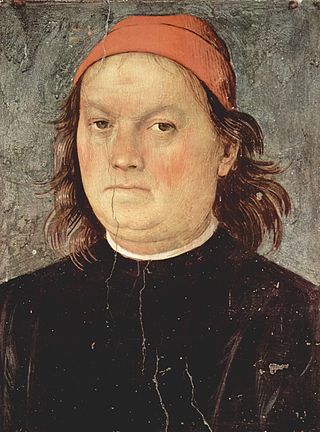
Fra Angelico was a Dominican friar and Italian painter of the Early Renaissance, described by Giorgio Vasari in his Lives of the Artists as having "a rare and perfect talent". He earned his reputation primarily for the series of frescoes he made for his own friary, San Marco, in Florence.

Fra Bartolomeo or Bartolommeo, also known as Bartolommeo di Pagholo, Bartolommeo di S. Marco, and his original nickname Baccio della Porta, was an Italian Renaissance painter of religious subjects. He spent all his career in Florence until his mid-forties, when he travelled to work in various cities, as far south as Rome. He trained with Cosimo Rosselli and in the 1490s fell under the influence of Savonarola, which led him to become a Dominican friar in 1500, renouncing painting for several years. Typically his paintings are of static groups of figures in subjects such as the Virgin and Child with Saints.

Andrea del Castagno or Andrea di Bartolo di Bargilla was an Italian painter from Florence, influenced chiefly by Masaccio and Giotto di Bondone. His works include frescoes in Sant'Apollonia in Florence and the painted equestrian monument of Niccolò da Tolentino (1456) in the Cathedral in Florence. He in turn influenced the Ferrarese school of Cosmè Tura, Francesco del Cossa and Ercole de' Roberti.

Fiesole is a town and comune of the Metropolitan City of Florence in the Italian region of Tuscany, on a scenic height above Florence, 5 km northeast of that city. It has structures dating to Etruscan and Roman times.

Pietro Perugino, born Pietro Vannucci, was an Italian Renaissance painter of the Umbrian school, who developed some of the qualities that found classic expression in the High Renaissance. Raphael was his most famous pupil.

Lorenzo di Credi was an Italian Renaissance painter and sculptor best known for his paintings of religious subjects. He is most famous for having worked in the studio of Andrea del Verrocchio at the same time as the young Leonardo da Vinci.

Santi di Tito was one of the most influential and leading Italian painters of the proto-Baroque style – what is sometimes referred to as "Counter-Maniera" or Counter-Mannerism.

San Marco is a religious complex in Florence, Italy. It comprises a church and a convent. The convent, which is now the Museo Nazionale di San Marco, has three claims to fame. During the 15th century it was home to two famous Dominicans, the painter Fra Angelico and the preacher Girolamo Savonarola. Furthermore, the church houses the tomb of Pico Della Mirandola, Renaissance philosopher and so called father of humanism.

Museo Nazionale di San Marco is an art museum housed in the monumental section of the medieval Dominican convent of San Marco dedicated to St Mark, situated on the present-day Piazza San Marco, in Florence, a region of Tuscany, Italy.

Francesco Granacci was an Italian Renaissance painter active primarily in his native Florence. Though little-known today, he was regarded in his time and is featured in Giorgio Vasari's Lives of the Artists.

Santa Maria del Carmine is a church of the Carmelite Order, in the Oltrarno district of Florence, in Tuscany, Italy. It is famous as the location of the Brancacci Chapel housing outstanding Renaissance frescoes by Masaccio and Masolino da Panicale, later finished by Filippino Lippi.

Santa Maria Maddalena dei Pazzi is a Renaissance-style Roman Catholic church and a former convent located in Borgo Pinti in central Florence.

Jacopo del Sellaio (1441/42–1493), was an Italian painter of the early Renaissance, active in his native Florence. His real name was Jacopo di Arcangelo. He worked in an eclectic style based on those of Botticelli, Filippino Lippi, and Domenico Ghirlandaio. The nickname Sellaio derives from the profession of his father, a saddle maker.

The Coronation of the Virgin is a painting by the Italian early Renaissance master Fra Angelico, executed around 1434–1435 in Fiesole (Florence). It is now in the Musée du Louvre of Paris, France. The artist executed another Coronation of the Virgin, now in the Uffizi in Florence.

The Badia Fiesolana was an medieval and renaissance period Roman Catholic monastery located in the town of Fiesole, northeast of Florence, Italy. Since 1976 the building is the main seat of the European University Institute. The original Camaldolese monks building was completed in 1028 and was subsequently transferred to Benedictines from Montecassino and the Canons Regular of St. Augustine.

Madonna with Child Enthroned between Saints John the Baptist and Sebastian is a painting by the Italian Renaissance artist Pietro Perugino, executed in 1493, and housed in the Uffizi Gallery, Florence.

The Fiesole Altarpiece is a painting by the Italian early Renaissance master Fra Angelico, executed around 1424–1425. It is housed in the Convent of San Domenico, Fiesole, central Italy. The background was repainted by Lorenzo di Credi in 1501.

Zanobi di Benedetto di Caroccio degli Strozzi, normally referred to more simply as Zanobi Strozzi, was an Italian Renaissance painter and manuscript illuminator active in Florence and nearby Fiesole. He was closely associated with Fra Angelico, probably as his pupil, as told by Vasari. He is the same painter as the Master of the Buckingham Palace Madonna. Most of his surviving works are manuscript illuminations but a number of panel paintings have also been attributed to him, including seven altarpieces and six panels with the Virgin and Child, along with some designs for metalwork.

San Domenico is a Romanesque and Gothic-style, Roman Catholic church located in the Piazza of the same name, with a north flank of the nave parallel to Corso Silvani Fedi, in Pistoia, region of Tuscany, Italy.

The church of San Giorgio alla Costa, called in earlier times also dei Santi Giorgio e Massimiliano dello Spirito Santo is a small historical church in the Oltrarno district of the centre of Florence, situated on the steep slope of via Costa San Giorgio which runs uphill from Ponte Vecchio to Forte di Belvedere.





















